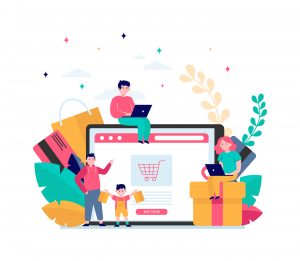
Deep Dive: E-Commerce Essentials
Hello, WISE women! This edition of Deep Dive is all about e-commerce - selling products or services online. E-commerce has grown almost 50% since 2019 with about 20% of all global retail sales coming from online sales this year, according to an eMarketer report. This growth is likely to continue, and more and more entrepreneurs are getting in on the action. This post will cover the basics of what e-commerce entails, including:
- The different types of e-commerce business models with pros and cons of each
- The main elements of an e-commerce business, from product pages to reverse logistics of returns
- Trends in e-commerce
This is a high-level overview intended for those considering building an e-commerce business and not a full guide to setting up and running one, though lots of those exist! See this one from Shopify or this guide from MailChimp for the how-to angle.
Dive deep into e-commerce
Types of e-commerce
When most people think of e-commerce, they think of buying products online. This is business to consumer, or B2C, though several other forms of e-commerce exist. In all, here are the main types of e-commerce:
- B2C: business to consumer, like Spanx, Clif Bar, Verizon, and other products and services individuals buy directly
- B2B: business to business, like Salesforce, Xerox, and others selling to companies specifically
- B2A: business to administration, meaning selling to governmental agencies, like Palantir.
- C2C: consumer to consumer, like eBay, Craigslist, and other peer-to-peer marketplaces
- C2B: consumer to business, like UpWork, Fiverr, and other platforms where individuals provide services to companies
Other terms you might hear are m-commerce (mobile commerce) and f-commerce (Facebook commerce), which are even more niche terms describing ways businesses sell their offerings.
You can also slice-and-dice e-commerce based on what is being sold: physical goods, digital goods, or services.
E-commerce business models
- Dropshipping - selling products you don’t ever handle yourself. For example, you might sell a widget to a customer for $20, then turn around and buy it from Alibaba for $8, who ships it directly to the customer.
- Pros: no inventory to manage, fewer processes to control, lower risk, low investment
- Cons: lower profit margins, no control over fulfillment or quality, reliant on your supplier, high competition.
- Print-on-demand - when you sell a designed product that’s made and shipped by someone else. For example, a designer sells a t-shirt with her design on it for $35, then pays a company to print and ship the shirt directly to her customer for $20. This is a form of dropshipping called print-on-demand.
- Pros and cons are similar to dropshipping.
- Makers - when you create, sell, and fulfill orders yourself, like an owner of an Etsy shop who makes jewelry by hand.
- Pros: total control over all aspects of the product, delivery, and service. Low initial investment, lower competition for unique/niche products.
- Cons: Large time investment and therefore potential for low margins, limited to your own skills, not easily scaled.
- Digital offerings - selling digital products like digital prints, ebooks, music, templates, online courses.
- Pros: No physical products to deal with, potential for high profit margins, easily scalable.
- Cons: High competition, copyright issues.
- Wholesaling & Warehousing - where you buy products in bulk and store them as inventory in a warehouse (or your home) until you sell them. You fulfill and ship orders directly or hire a third party to handle those aspects.
- Pros: Higher potential profit margins than dropshipping, more control over inventory, fulfillment, and shipping
- Cons: More risk if inventory doesn’t sell, more processes to manage, higher up-front investment and overhead
- White labeling - buying manufactured goods and selling them under your label (and sometimes adding your own branding) so it looks like you’ve manufactured them.
- Pros: Higher profit margins, can sell a range of products, less risk than manufacturing.
- Cons: Higher investment, more complexity, quality control, more competition
- Manufacturing - having products manufactured specifically for you. You own the pipeline from creation through to shipping, though you can outsource any piece of it.
- Pros: Highest profit margins, especially if you work with manufacturers overseas. Most control over the supply chain, fulfillment, and shipping
- Cons: Huge investment, very difficult to pivot if the product doesn’t sell, many processes to monitor, quality control
Elements of an e-commerce business
In this section, we’ll break down the main pieces of an e-commerce business to understand what it takes to build and manage one. Most e-commerce businesses are built on an e-commerce platform, most of which make it easier to manage all the elements outlined below. Shopify, Squarespace, Wix, and Woocommerce are population options.
Regardless of which platform you use, you’ll need a defined selection of products or services. It’s often a good idea to have a niche vs. selling a wide, unrelated group of products. For physical goods, consider how you’ll manage inventory and your supply chain, and make contingency plans in case of supply chain disruption.
Offerings are displayed in your store either as one single catalog and/or divided into specific categories. Each product or service should then also have its own product page where high-quality images, product information, price, and more is displayed. For services, customers can sometimes book a time for their appointment or consultation.
You’ll also need to configure your shopping cart software, which is like a portal for order, inventory, and customer management. Many platforms have built-in shopping cart software. From a customer’s POV, this system allows them to add things to their cart and make changes. It’ll also calculate taxes, apply any coupons or discounts, capture billing and delivery addresses, give options for delivery, and display info about shipping and handling time. Shopping carts often can be configured to offer targeted upselling options, like by presenting add-ons related to items in the cart. On the backend of this system, you as the business owner are able to view and manage orders, inventory, and customer profiles.
That cart system then connects to the payment gateway, which processes a customer’s payment, provides a receipt, and deposits funds into your account after deducting any processing fees.
Once the order is placed and payment is processed, the order must be fulfilled. For digital products, you’ll need to provide a download link. For services, you must provide information that explains how they’ll be able to access that service. The logistics involved with getting a physical product to your customer depends on your business model, but often involves inventory management, packing, and shipping. For products coming from overseas, customs will be involved as well. Many third party providers offer fulfillment services to e-commerce businesses.
Customer service must be available before, during, and after purchase. Visitors to your site should be able to have their questions answered quickly, many of which may be addressed through things like an FAQ, descriptive product pages, and clear policies around shipping and handling, returns and refunds, and privacy. Many people also expect to be able to ask questions directly through email support, a chat bot, social media channels, or via phone. Once a purchase is made, it’s common to include details on how to contact customer service in an order confirmation email. Proactive businesses interested in customer feedback often reach out after a sale to capture data on customer satisfaction, collect customer testimonials, and find ways to improve their offerings.
Reverse logistics refers to the process of handling returns, exchanges, and refunds. This includes how a customer contacts support, initiates a return or exchange, and gets the product back to you or your warehouse. Business owners must also consider how returns impact inventory management, how quickly refunds or exchanges are processed, and how communication with the customer is handled along the way.
Finally, how you drive traffic to your store is a critical factor to consider and part of your overall customer acquisition strategy. For most e-commerce businesses, traffic comes from a combination of sources, including organic search, organic social media, paid search, paid social media campaigns, affiliate marketing, email marketing, display marketing, and other channels. Many businesses that have both a physical retail space and an e-commerce store will integrate the two, marketing their digital store in their physical space and vice versa.
Trends to watch out for
Artificial intelligence is playing a bigger and bigger role in e-commerce. AI drives many features that provide an enhanced customer experience, like personalized product recommendations, voice search, chatbots, facial recognition for payment, and augmented reality allowing customers to see a product in their own space. AI also supports e-commerce businesses behind the scenes, like through predictive inventory management and fraud protection.
Consumers’ demand for sustainability continues to rise, with several studies showing demand increasing for more sustainable products and packaging, and consumers actively considering sustainability, along with price and quality, during their decision making. This is especially true of younger demographics.
Outsourcing some of the work to third-party logistics providers, sometimes referred to as 3PLs, is increasing in popularity. These providers offer warehousing, import, fulfilment, and reverse logistics services to reduce the amount of processes a business owner must manage.
Many e-commerce businesses are taking a mobile-first approach, meaning they design their stores and shopping experiences primarily for customers shopping on their phones. This makes sense as mobile commerce (or m-commerce) makes up 32% of all e-commerce in the US and is predicted to grow steadily.
Read, watch, listen
- The Balance Small Business has an entire section of their website dedicated to e-commerce - the basics, strategy, trends and challenges, and more.
- Shopify has a whole guide with text, video, and graphics that serves as a roadmap to building, launching, and growing an e-commerce business.
- SalesForce has a cool visual overview of statistics and trends in online shopping based on data from 1 billion shoppers.
- Kensium released a guide for how e-commerce businesses can prepare for the 2021 holiday season. Etsy offers a similar guide tailored to makers as part of their seller handbook.
Connect with us
E-commerce is a HUGE topic with endless complexity. If you want to talk through your e-commerce ideas, get help troubleshooting a specific issue you’re facing, or just ask a quick question, reach out to us at wisecenter@syr.edu.
